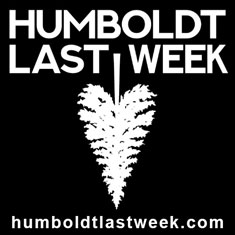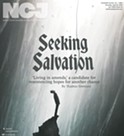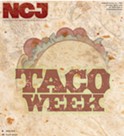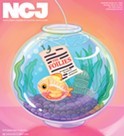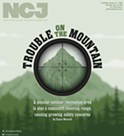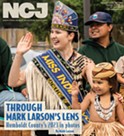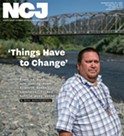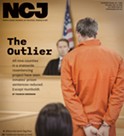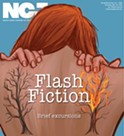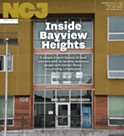Jaso at the Bat
In a season of big promise, Humboldt's crackerjack catcher takes a bad hop
By Grant Scott-Goforth [email protected] @GScottGoforth[
{
"name": "Top Stories Video Pair",
"insertPoint": "7",
"component": "17087298",
"parentWrapperClass": "fdn-ads-inline-content-block",
"requiredCountToDisplay": "1"
}
]
It's a hot and humid afternoon in Atlanta, Georgia, and Oakland Athletics catcher John Jaso is getting a rare break from batting practice. The Atlanta Braves are doing some kind of promotion on the field, which gives the 30-year-old Humboldt native a chance to chat with a hometown reporter.
When the A's PR guy hands Jaso the phone, he's chipper, confident and relaxed despite heading into the most difficult stretch of the season.
Yes, it's a game. But September is hard on baseball players. With 162 regular season games, a rigorous travel schedule and few days off, fatigue typically begins to set in around the end of August. But Jaso has playoffs — and the World Series — on his mind. "You might be hurting and everything right now but it's so close to the end you push through," Jaso said. "We're competing. We're in first place in our division."
In his publicity shot, Jaso's got a half smile (like he's about to laugh, something you can hear in his voice), thick stubble and short hair under his green and gold cap. He looks like a natural-born Humboldter; a few years ago, when he played for the Seattle Mariners, he sported a barely-trimmed beard. When he began with Oakland, in 2013, his hair was nearly shoulder-length.
At home plate, he holds the bat high behind him, an upright but comfortable-looking stance that allows for a speedy swing of the bat. And when No. 5 connects, he connects. That swing's taken nine balls out of the park this season and sprayed 81 hits.
Despite his posture over home plate, Jaso is soft-spoken and unassuming. He sounds genuinely humbled to be playing major league ball, appreciative of the circumstances that led to his success. Part of that success is due to a particularly savvy new management style that's crept into baseball over the last couple decades. There is, perhaps, no better current incarnation of "moneyball" than Jaso.
What Jaso doesn't say, on that Aug. 16 afternoon, is that he's been suffering concussion symptoms since taking a hard foul ball off his mask in early August. The symptoms — nausea, pain, "fuzziness" — are getting worse every day.
Fast forward one month and things have changed dramatically from mid-August, when the team was tied for the division lead and the best record in baseball. The A's have fallen 10.5 games behind the Angels in the race to win their division, and cling to a wild card spot that would get the team into the playoffs if it can't climb back on top of the American League West. In an eerie repeat of his 2013 season, Jaso has sat out more than 20 games since Aug. 25 — just a week after he talked with the Journal — with severe concussion symptoms.
"He's kind of in a tough patch right now," said his dad, Greg Jaso. John's recovery time was extended last week following a visit to a concussion specialist, and it's unclear at this point if he will return to help the tailspinning A's for the rest of 2014. "I think the team could use him," Greg said.
John Jaso grew up hiking and camping around Humboldt County and beyond, and he still takes every opportunity to explore the outdoors. But there aren't many of them during the six-month baseball season. The downside of wanting a World Series title: "If the postseason takes us into November, then camping season is pretty much gone," he said.
Jaso mentions his dad enough during the phone call from Atlanta that it's clear he's been a huge influence on the 30-year-old's life. In a promotional interview after joining the A's, John cited his father as his hero.
Greg Jaso lives in McKinleyville and works as a dentist for the United Indian Health Services. He shares his son's humility — when asked what would have inspired John to name him as his hero, Greg joked, "I dunno. He hasn't been around that much I guess."
John grew up the oldest of four siblings — one brother lives in McKinleyville, another moved to Florida to become a municipal firefighter, and his sister's a pastry chef for Pixar. When each of the Jaso kids graduated eighth grade, Greg took them on a trip. He and John spent a week on the Boundary Waters in Minnesota fishing, canoeing and camping. "It was one of those father-son things where you really connect," Greg said. "We've got more of a bond than a 'hero' thing."
When the Jaso brood was growing up, the family would play pickle or "fenceball" — a game in which Greg would hit grounders across a gopher-riddled backyard. If one of the kids made a clean catch, they'd get a point. If the ball pinged the fence behind them, the point was Greg's.
John's raw talent, Greg conceded, likely came from his mom's side. John's grandfather spent years fending off scouts from the Chicago White Sox, determined to start a medical practice, and several of John's uncles on that side played baseball in college.
Greg said John's baseball commitments outweigh his backcountry pining. "He talks a lot about coming home and going up to the Trinity Alps," Greg said.
A few years ago, Jaso asked then-girlfriend Shannon to marry him while they were backpacking in the Trinity Alps. "I proposed to her up there so she couldn't get away," he said, laughing. (She said yes.) On their last day, his dad met them with champagne, smoked salmon and cheese. "That was like a 10-mile hike for him," Jaso said.
Jaso's permanent home is in Florida, where it's easier to go through spring training, but he still loves Humboldt. In the meantime, he hikes in the Bay Area when he can, and sees Shannon whenever possible. When he spoke to the Journal, Shannon was planning to travel to Atlanta from Florida, where she's attending business and marketing school, so they could spend a day together. "It's always tough doing baseball in a relationship," he said.
And Jaso still talks regularly with some of his former coaches and teachers, including Dustin Dutra, who coached him at McKinlevyille High School and taught history and government classes.
"He was a big part of my baseball life growing up as a kid," Jaso said. "We still keep in touch. I send him gear once in a while — extra wood bats he can use during batting practice."
Dutra's been coaching McKinleyville High baseball for 19 years, and says that, in hindsight, he could see Jaso had the makings of a pro ballplayer.
"Just in our area and just in high school baseball there have been a lot of talented players that have come through," Dutra said. "Part of it, though, is ... perseverance. If you're not going to make the major leagues in the first couple years, are you going to be willing to grind it out a little bit and be patient? And then, when your opportunity comes, you know, [will you be ready to] jump on it?"
Jaso spent five years playing minor league baseball before getting his shot, in 2008, with the Tampa Bay Rays, a scrappy, relatively new team that shares a division with two baseball megaweights: the New York Yankees and the Boston Red Sox.
It was in Tampa Bay that Jaso became part of an esoteric trend in baseball management. The sport has long bred an obsession over statistics; fans have been poring over players' efficiencies and weaknesses via their scoring, defensive and pitching averages for a half century, and in the last few decades, fantasy sports (played competitively using real-life players' stats) have added to the popularity of baseball's numbers game. But number-crunching has moved beyond the realm of the Excel-wielding super fan. Coaches, owners, scouts — teams — have begun paying attention.
While he's built for baseball — naturally talented, perseverant, with a good disposition for the game — Jaso isn't a headlining player or a household name. But with careful planning, teams have found a way to capitalize on his strengths, employing vast spreadsheets of hyperanalytical figures — a wonky tactic known as sabermetrics.
The Oakland Athletics have been turning heads for a little more than a decade now, becoming a cult favorite for the team's now-famous brand of management: "moneyball."
Michael Lewis' 2003 book of that name (subtitled "The Art of Winning an Unfair Game) exposed the A's crafty strategies. The team, under General Manager Billy Beane's direction, had quietly become the world's best sabermetrics analysts. Eschewing the tradition of baseball scouts (who relied on instinct as much as numbers), the team broke players' broad statistics into hyper-specific nodes, allowing it to stack its rosters with relatively cheap players with undervalued skills. And it worked. But after Moneyball came out Oakland's tactic was exposed, and the underdog's secret was co-opted by the rich teams, who — given the same data sets and valuations — could build even bigger, broader teams of number-crunchers.
Jaso's online profile, like any major leaguer, features a breakdown of how well he has hit: by batting order, by pitch count, by field, by time of day, by whether he's playing on grass or turf.
Tampa Bay's front office must have realized, in 2008, that John Jaso, who bats left, hits very well against right-handed pitchers. In order to make up for his weaker numbers against lefties (for his part, Jaso says he "used to hit lefties pretty well"), a strategy was born: Start Jaso when the opposing team starts a right-handed pitcher, and start another catcher against lefties. It's not a new concept — Jaso's former coach, Dutra, says it goes back in popularity to at least the 1980s Toronto Blue Jays (though, really, it's existed since baseball's inception) — but it's employed effectively by cash-strapped teams like the Rays and Athletics who can't afford marquee players.
"The Oakland A's have created a monster," read a headline at the beginning of the 2014 season referencing the Frankensteinian catcher position. Jaso was in a two-man "platoon" with the fearsomely bearded right-hander Derek Norris. The duo "would rank 14th in the league at the moment, if the A's catchers were one player," the story noted toward the end of May. Another writer, lauding the tandem catchers for people building fantasy teams, called it the "platoon of awesomeness."
The A's won the American League West in 2012 and 2013. A June New York Magazine article claimed, "Most teams would look at players like A's catchers John Jaso and Derek Norris and lament how badly they struggle against pitchers who throw from the same side of the plate as they hit. This is seen as a liability. But Beane and the A's see it as a potential strength." New York Magazine called it a "new brand of moneyball."
"That's a perfect example of capitalizing on peoples' strengths and putting them in positions where they're going to be successful," Dutra said.
Not only effective for a team's success, it's potentially cheaper for a team to carry two — even three — contracts for relatively cheap situational players than one catcher who, say, appeared on a video game cover.
Though efficient, the strategy is potentially problematic. "Every player wants to play every game," Dutra said.
But not in Jaso's case. "I like it," Jaso said. "That's just something that I've done since I reached the big leagues. As long as I'm in the big leagues — and I'm thought of in a role — I can't [complain]."
Insider baseball, the obsession with turning every tense showdown between pitcher and batter into a datum in a sea of figures, is lost on Jaso.
"I wasn't really a big sports guy growing up," he said, without a hint of irony.
It's almost laughable, coming from someone who's worked so hard, for so many years, to become a professional athlete. But he doesn't mean to sound unappreciative.
"I played baseball," he said. "I never skipped a season of baseball. Baseball was always for me but I never followed baseball."
His grandparents took him to San Diego Padres games when he'd visit them as a kid, but he didn't really have a favorite team. He'd spend his free time "going camping and stuff with my dad."
"Even in the minor leagues I wasn't checking out everybody's stats," he said. "I'd concentrate on myself and be the best that I could be."
John Jaso's not the first Humboldt County kid to make it in the big leagues (Eureka natives Garth and Dane Iorg played major league ball in the 1970s and 1980s), but he's the county's only current major league player, carried there largely by perseverance.
By the time Jaso was nearing high school, he had already distinguished himself in the Humboldt County Babe Ruth leagues, according to Dutra, his high school coach. "He was a standout player," Dutra said. "I think the talent was pretty obvious back then. ... Especially if you watch him swing the bat, he had a very nice, refined, compact swing back then and he was one of those guys you can pretty much put anywhere on the field and he was going to do great."
Greg Jaso said his son was naturally talented, but so were many kids he played with. "It wasn't like 'Wow, this kid is going places.' He was a consistent, solid player."
After junior high in Trinidad, Jaso started at McKinleyville as a second baseman, but he bounced all over the field. Dutra said he distinctly remembers Jaso's first varsity start in his sophomore year. "John had a couple chances to pinch hit early in the year and had some good at bats," Dutra said, adding that he was starting to get pressure to put Jaso in regularly. "We have a nonleague game, and so I start him, and the first two at-bats in that start he hits homeruns. In the same inning."
After that, Dutra said, "we just kind of threw him in the outfield just to get his bat in the lineup. He hadn't played a whole lot of outfield before but he did a pretty decent job, and then junior and senior year he played a lot of catcher, pitcher and some shortstop for us."
All the while, Jaso was a consummate teammate. "I never heard him say 'I, I, I' or 'me, me, me' or anything like that," Dutra said. "He didn't demand any kind of attention whatsoever, he just went about his business and got along with everybody on that team."
Greg partially attributes good coaching to Jaso's's composure in the game. "John's always had this calm demeanor in his approach to the game. He doesn't get ... hyper-excited, fist pumping. He doesn't get ticked off from a bad call."
Not many people have anything negative to say about Jaso.
"I remember someone telling me when John was going to college, 'You watch, there's going to be a long line of people trying to take credit for John's success,'" Dutra said. "I'm just happy John played on our team."
After graduating high school in 2001, Jaso took a scholarship to play baseball at Southwestern College in Chula Vista, California. "I was just thinking about getting my education paid for; using baseball as a tool to get me through school," Jaso said. He was planning to get a teaching degree when he was approached by a pro scout. "That's when it really hit me that I could play professional baseball," Jaso said. In 2003, after two years playing for Southwestern College, the Tampa Bay Rays drafted him in the 12th round. He had a decision to make: Sign, or take another scholarship to play baseball for San Diego University, a private Jesuit school. He signed. "This kind of fell onto me," he said. "It was an opportunity that I knew I had to take." (As part of his signing contract, the Rays agreed to pay for two years of school post-baseball, an offer that Jaso plans to take advantage of. It made his decision to sign a little easier.)
He began working his way up the minor leagues, playing for A, then AA and finally AAA leagues in Hudson Valley, New York, southwest Michigan, Visalia, California, and Montgomery, Alabama.
"Some of the funnest seasons I had were during my minor league career," Jaso said. "We were in it together, man. We were scraping by on our paychecks, being super homesick and still grinding out through a season."
All the while, he said, his family encouraged him. "It might just seem like playing a game for a living, but it's stressful, man," he said. "The stress does compound when you get higher up the ladder."
During the best season of his career (when he was earning $1,200 a month), he hit a summertime slump, only getting two hits in July. "What am I doing? Am I wasting my life?" he asked himself. "When you have family there supporting you and still cheering you on, it helps you get through those times. I don't think I could have made it [otherwise]."
After winning the AA championship in 2007, Jaso was called up to the Rays in September 2008, shortly before the team would face the Philadelphia Phillies in the World Series. Jaso was in a reserve spot — he only had 10 at-bats with the Rays in 2008 — but he earned an American League Championship Series ring for his place on the team. He was dropped back down to the minors in 2009 and played no major league games that year, but in 2010 he finally got his permanent call-up. That year he would play 109 games, putting up a .263 batting average.
One of Jaso's career highlights came on Aug. 15, 2012, when he caught Seattle Mariners ace Felix Hernández's perfect game. For nine innings the 26-year-old Venezuelan hurled 113 pitches into Jaso's glove, retiring 27 batters without letting a single one reach first base. It was the 23rd perfect game in baseball history, and Jaso called it one of his own biggest moments. "After we were done we were hanging out in the clubhouse for a few hours talking," Jaso said. "Felix was waiting to talk to the president of Venezuela. Hugo Chavez was calling up."
Hernández bought Jaso a Rolex watch as a token of his appreciation, giving it to him in 2013 when the Mariners played Jaso's new team, the A's. Jaso returned the favor by disrupting Hernández's bid for another perfect game; after Hernández had retired 10 batters, Jaso knocked a double into the outfield in the fourth inning. Hernandez reportedly responded with a grin from the mound.
Jaso's tenure with Oakland — concussion issues aside — has been positive for him. He praised the A's organization, saying the coaches are up front with the catchers about when they'll play. "That stuff is nice to have during a long season."
And his teammates?
"Our clubhouse here is awesome," he said. "I've been in clubhouses that weren't so great. That makes a really long season."
As a nation, we love underdogs, and Oakland's club fits that bill, with its deteriorating stadium, slim bankroll and lack of a World Series title since 1989. But the team makes up for that in enthusiasm, gumption, humor and camaraderie. When one scruffy player hits a homerun, he runs through a tunnel his teammates form in the dugout.
This all makes for an imminently watchable group of players. Of course, things change quickly in baseball. Beane dropped jaws in August when he traded young slugger Yoenis Cespedes for two Boston Red Sox players, part of an apparent bid to load the offensively solid team with great pitching for the postseason.
"I was surprised," Jaso said. "We didn't expect to see Cespedes go. We thought that was a piece of the puzzle. You can tell with that we're definitely going for it this year."
The A's were first in their division when the trade went through. As of Tuesday morning, the team was 10.5 games back. Meanwhile, Jaso, who is in a one-year, $2.3 million contract, sits out with concussion symptoms.
Concussions are serious matters. After decades of accepting head-rattling plays in the realm of professional sports, owners, coaches, players and (maybe) fans are finally taking them seriously. Several years ago the National Football League began imposing in-game precautions following a string of high-profile suicides — and ensuing lawsuits — of former players attributed to repeated head injuries from the game. Awareness seems to have spread to Major League Baseball. Catchers, particularly, are vulnerable to concussions, with their frequent collisions with runners, backstops and foul balls.
Jaso missed the second half of the 2013 season (he led the team in on-base percentage when he was sidelined) while he recovered from a concussion. Then, in early August, Jaso took a hard foul tip off of his mask. The concussion symptoms returned. He was nauseous, dizzy, in pain. Like migraines, concussions can be heightened by bright lights and loud noises —September ballparks aren't the friendliest environs for someone seeking concussion relief. The A's put Jaso on a seven-day disabled list status — a way for teams to add to their roster by temporarily substituting their injured starting player with someone fresh. But a week later Jaso was still feeling "fuzzy," having trouble seeing the ball as it approached the plate. He's currently on a 15-day disabled list.
If Jaso does come back in the 2014 season, it's unclear what his role will be. His platoon-mate, Norris, has been the starting catcher in most appearances since Jaso was hurt. The A's may not want to risk Jaso getting injured again, or may not have confidence that he is well enough to spend nine innings behind the plate, but they could tap him to be a designated hitter (A's pitchers don't hit unless the team is away playing a National League team) or a pinch hitter. A's Manager Bob Melvin told MLB.com last week that he wasn't surprised that Jaso was told by a specialist that he needed more time to recover. "On a personal level, I'm more worried about the person than I am the baseball player," Melvin said.
It's frustrating, no doubt, to be that close to what looks like a banner year, only to have your status — and the possibility of seeing a single playoff at-bat — thrown into uncertainty by a routine foul tip.
In spring training this year, Jaso told a Comcast Sports Net reporter about his frustrations over missing the end of 2013. "Nobody really likes being on the DL and being that guy that has to go into the training room and sit there all day," he said. "That part was a little bit depressing."
Jaso hasn't spoken to the media since his most recent concussion, but his dad, Greg, recently came back from visiting him in the Bay Area. Greg said his son is still looking forward to some game time — even if it's limited — with the A's this season.
"He's in the kind of career where you've got to be on top of your game at all times," Greg said. "Especially as a catcher — you're tracking moving baseballs coming in at 90 mph. You've got to have your wits about you.
"It's tough because he's worked so hard at it. It took a long time get to where he is today. He, more than anybody, knows what an honor and blessing it is to take it that far. That's one of the things I'm proud about. It's one thing to make it on your physical attributes. It's another how you handle yourself along the way, the ups and downs."
When John Jaso talked to the Journal in August, his mind was on the postseason. "It'd be nice to get a World Series ring," he said with a modest chuckle.
But while baseball in August and September is all-consuming, there's a sliver of room in Jaso's mind that thinks about school, about teaching and coaching after the major leagues, about his family, and about the pristine lakes high in the Northern California mountains.
more from the author
-
Flamin' Hot's Stale Corporate Propaganda
- Jun 15, 2023
-
Hell is Visiting Other People
- Sep 22, 2022
-
The Bear Roars
- Aug 18, 2022
- More »
Latest in News
Readers also liked…
-
Through Mark Larson's Lens
A local photographer's favorite images of 2022 in Humboldt
- Jan 5, 2023
-
'To Celebrate Our Sovereignty'
Yurok Tribe to host gathering honoring 'ultimate river warrior' on the anniversary of the U.S. Supreme Court ruling that changed everything
- Jun 8, 2023





